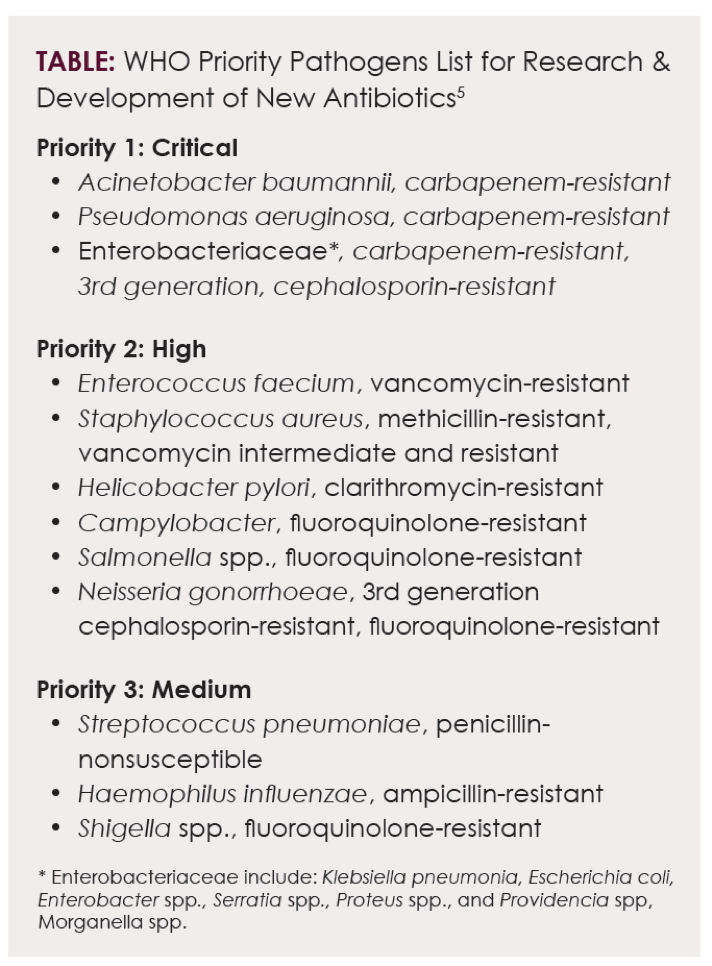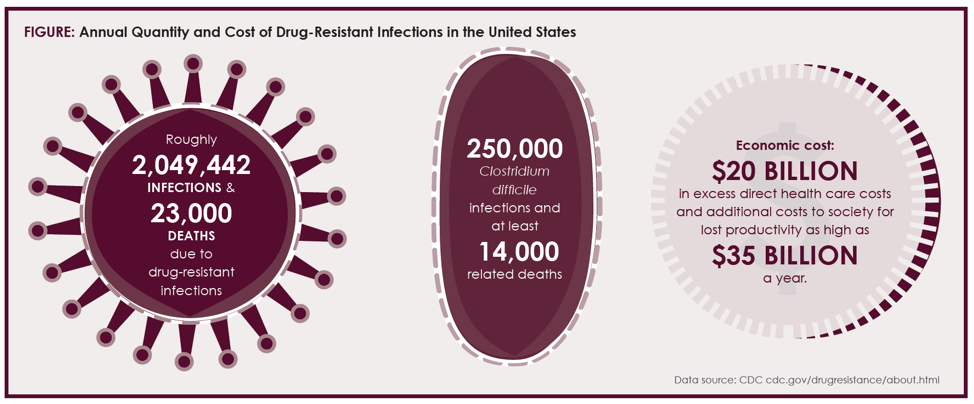Antimicrobial Resistance: Forging A New Strategy Against an Old Threat
Bacteriophages are emerging as an alternative to treat highly resistant infections.
Antimicrobial resistance (AMR) is sadly not a new threat, and despite Alexander Fleming’s warnings about resistant bacteria rising up because of the frequent and misuse of antibiotics,1 only fairly recently have individuals truly started to pay attention. Not only is there a growing threat of resistant bacteria, but the development of new antibiotics has been woefully insufficient. A recent report found that “of the drugs in development, only 12 have the potential to address the most critical Gram-negative pathogens on the World Health Organization’s antibiotic-resistant priority pathogens list: carbapenem-resistant Enterobactericaeae, Pseudomonas aeruginosa, and Acinetobacter baumanii (see Table for the complete list.)

Furthermore, bacteria resistant to 1 antibiotic in a class are more likely to be resistant to others in that class and only approximately 1 in 4 antibiotics represent new drug classes or mechanisms of action to combat bacteria that are constantly evolving.”2
The challenges of drug research and development are startling in light of the predictions for AMR: 10 million deaths worldwide per year by 2050 and $100 trillion lost between now and then in terms of global production.3 Current data indicate that there are approximately 23,000 deaths in the United States already each year, and about $20 billion in excess direct health care costs (see Figure).
What is to be done? There are several initiatives, like the Combating Antibiotic Resistant Bacteria Biopharmaceutical Accelerator (CARB-X), that seek to infuse life into the research and development of new drugs. There is also a push on health care providers and agriculture to reduce the use of antimicrobials. But these are all long-term solutions that may take years or decades to implement. Although long-term plans are critical, if you were hospitalized today with a highly resistant infection, what would be the short-term plan of action your heath care providers would take?
One strategy that’s gathering momentum as an alternative to antibiotics is the use of bacteriophages (or phages), which are viruses that infect good bacteria and use them to produce more phages that continue the assault on the bacteria. Phages replicate quickly, and phage therapy is becoming a more viable approach because it has a narrow host range. This may not sound like a good thing, but the very specific bacterial targeting that certain phages have (and more phages exist than stars in the universe) means they can be used for a targeted approach. Not all bacteria are bad, and part of the problem so frequently seen with infections, like Clostridium difficile, is that antibiotics kill off a lot of good bacteria in the process of killing the bad. Phage therapy has the capacity to selectively kill specific bacteria within an ocean of bacteria. Harnessing phages that can attack certain bacteria with almost laser-like precision is exactly what is needed in when tackling resistant bacteria. Imagine a room full of people with 1 villain. Would you rather have a sniper capable of taking out just the villain or a shotgun that could potentially harm innocent bystanders? Phage therapy has a sniper-like selectivity that makes it extremely effective, but without the negative adverse effects so often seen with antibiotics.
A recent application of this approach to resistant infections was seen for the first time in the United States, when a patient with a severely resistant and systemic infection was treated with intravenous (IV) bacteriophages. The patient was near death, but recovered after the treatment and is now a model for the success of phage therapy. Team member, Robert Schooley, MD, chief of the Division of Infectious Diseases at the University of California San Diego School of Medicine noted, “We don’t yet fully understand the potential—and limitations—of clinical bacteriophage therapy, but it’s an unprecedented and remarkable story, and given the global health threat of multidrug-resistant organisms, one that we should pursue.”4

Another researcher who is working to make phage therapy a more viable and utilized approach to battling highly resistant infections is Benjamin Chan, PhD, an associate research scientist at Yale University. His research focuses on developing and creating virulence targeting antibiotics and resistance targeting antibiotics (RTAs), and he has been able to use bacteriophage-based RTAs in humans. Dr. Chan’s research also involves looking at a unique place to find phages—sewage, where bacteria thrives. What better place to find phages that prey on bacteria? Phage hotspots aren’t limited to the most obvious places, but truly any place you might fight bacteria, which happens to be everywhere.
Dr. Chan discussed his research, the potential of phage therapy, and what it means for health care providers. “Bacteriophage therapy is an approach that could be especially valuable in tackling AMR because [phages] self-amplify/ limit in the presence [or] absence of susceptible hosts (ie, bacteria), they can be used alongside chemical antibiotics, they have killing mechanisms distinct from currently used chemical antibiotics, they can readily be isolated from the environment should bacteria become resistant to a particular phage, and they can also select for reduced virulence and antibiotic sensitivity by forcing evolutionary trade-offs in pathogenic bacteria. My experience in treating 2 people suffering antibiotic-resistant infections was pretty straightforward, as there is an efficient and functional process for applying for permission from the US Food and Drug Administration.”
Given the capacity for phage therapy to treat extremely resistant infections, I was curious as to Dr. Chan’s suggestions and words of wisdom for medical providers. “For medical providers, I would suggest that they carefully evaluate their patients as candidates for this treatment at this stage because we are in the dangerous territory of a single case going poorly and the medical community responding with a, ‘See? We told you it wouldn’t work’ and phage therapy being killed as a potential therapeutic. Once phage therapy becomes more accessible, I’d suggest that practitioners carefully review the pros and cons of phage therapy. While they are certainly antibacterial, they are distinct in several ways [that] should be understood before undertaking this approach to infection management.”
AMR is a difficult problem that stems from so many industries and poor practices. A solution will require a multitude of tactics and approaches, of which bacteriophage therapy has the potential to save lives as we search for prevention.
Ms. Popescu is a hospital epidemiologist and infection preventionist with Phoenix Children's Hospital. During her work as an infection preventionist, she has performed surveillance for infectious diseases, preparedness, and Ebola-response practices. She is currently a PhD candidate in Biodefense at George Mason University where her research focuses on the role of infection prevention in facilitating global health security efforts. She is certified in infection control.
References
- Rosenblatt-Farrell N. The landscape of antibiotic resistance. Environ Health Perspect. 2009;117(6):A244-A250.
- Talkington K, Visi D, Paulin S. The world is running out of antibiotics. The Pew Charitable Trusts website. pewtrusts.org/en/research-and-analysis/analysis/2017/12/21/the-world-is-running-out-of-antibiotics. Published December 21, 2017. Accessed on January 2, 2018.
- Tackling drug-resistant infections globally: final report and recommendations. Review on antimicrobial resistance website. amr-review.org/sites/default/files/160525_Final%20paper_with%20cover.pdf. Published May 2016. Accessed December 31, 2017.
- LaFee S, Buschman H. Novel phage therapy saves patients with multidrug-resistant bacterial infection [news release]. San Diego, CA: UC San Diego Health; April 25, 2017. health.ucsd.edu/news/releases/Pages/2017-04-25-novel-phage-therapy-saves-patient-with-multidrug-resistant-bacterial-infection.aspx. Accessed December 4, 2017.
- Global priority list of antibiotic-resistant bacteria to guide research, discovery, and development of new antibiotics. Report on WHO website. who.int/medicines/publications/WHO-PPL-Short_Summary_25Feb-ET_NM_WHO.pdf. Published February 27, 2017. Accessed February 1, 2018.

